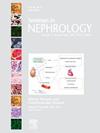Acute Kidney Injury in Non-falciparum Malaria
IF 3.5
3区 医学
Q2 UROLOGY & NEPHROLOGY
引用次数: 0
Abstract
Acute kidney injury (AKI) complicates non-falciparum malaria, particularly that from Plasmodium knowlesi. AKI (any KDIGO stage) is present in 20-30% of hospitalized patients with knowlesi malaria, with age >45 years having a sixfold risk of AKI. WHO-defined severe AKI (creatinine >265μmol/L) is found in ∼2.5% of adult knowlesi hospitalizations and 60% of deaths, with pathogenesis linked with intravascular hemolysis, endothelial activation, glycocalyx degradation and acute tubular necrosis (ATN). Paracetamol may have a renoprotective effect in severe knowlesi AKI, including reductions in medium-term proteinuria. WHO-severe AKI has been estimated by meta-analysis as occurring in 0.01% of combined hospital inpatient and outpatients with P. vivax malaria with unexplained geographic heterogeneity and incomplete systematic exclusion of comorbidities. Despite a paucity of community-based P. vivax KDIGO-defined AKI studies, one such study identified AKI in 10% of adults and children with vivax malaria, almost all KDIGO stage 1. AKI pathogenesis in vivax malaria is not well characterized; an exception is 8-aminoquinoline drug-induced acute hemolysis and ATN in patients with G6PD deficiency. AKI risk in malaria from P. malariae and P. ovale is poorly characterized and may be underrecognized. Long-term outcomes of AKI, including CKD and cardiovascular disease, are unknown in non-falciparum species, and longitudinal studies are needed.
非恶性疟疾的急性肾损伤。
急性肾损伤(AKI)可引起非恶性疟疾,特别是诺氏疟原虫引起的急性肾损伤。20-30%的诺氏疟疾住院患者存在AKI(任何KDIGO阶段),年龄在45岁以下的患者发生AKI的风险为6倍。世卫组织定义的严重AKI(肌酐浓度为265μmol/L)发生在约2.5%的成人住院患者和60%的死亡患者中,其发病机制与血管内溶血、内皮活化、糖盏降解和急性肾小管坏死(ATN)有关。对乙酰氨基酚可能对严重的knowlesi AKI有保护肾的作用,包括减少中期蛋白尿。经荟萃分析估计,世卫组织严重急性肾损伤发生率为0.01%的间日疟住院和门诊合并患者,存在无法解释的地理异质性和不完全系统地排除合并症。尽管缺乏以社区为基础的间日疟KDIGO定义的AKI研究,但其中一项研究发现,10%的间日疟成人和儿童患有AKI,几乎全部为KDIGO 1期。间日疟AKI发病机制尚不明确;例外是8-氨基喹啉药物引起的G6PD缺乏症患者的急性溶血和ATN。来自疟疾疟原虫和卵形疟原虫的疟疾的AKI风险特征不明确,可能未得到充分认识。AKI的长期结果,包括CKD和心血管疾病,在非恶性物种中是未知的,需要纵向研究。
本文章由计算机程序翻译,如有差异,请以英文原文为准。
求助全文
约1分钟内获得全文
求助全文
来源期刊

Seminars in nephrology
医学-泌尿学与肾脏学
CiteScore
5.60
自引率
0.00%
发文量
27
审稿时长
6-12 weeks
期刊介绍:
Seminars in Nephrology is a timely source for the publication of new concepts and research findings relevant to the clinical practice of nephrology. Each issue is an organized compendium of practical information that serves as a lasting reference for nephrologists, internists and physicians in training.
 求助内容:
求助内容: 应助结果提醒方式:
应助结果提醒方式:


